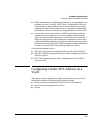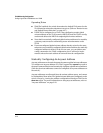
4-14
IPv6 Addressing Configuration
Configuring a Static IPv6 Address on a VLAN
Operating Notes
■ With IPv6 enabled, the switch determines the default IPv6 router for the
VLAN from the router advertisements it receives. (Refer to “Router Access
and Default Router Selection” on page 4-27.)
■ If DHCPv6 is configured on a VLAN, then configuring a static global
unicast address on the VLAN removes DHCPv6 from the VLAN's config-
uration and deletes the DHCPv6-assigned global unicast address.
■ Note that for a statically configured global unicast address to be routable,
a gateway router must be transmitting router advertisements on the
VLAN.
■ If an autoconfigured global unicast address already exists for the same
subnet as a new, statically configured global unicast address, the statically
configured address is denied. In the reverse case, you can add an auto-
config command to the VLAN configuration, but it will not be imple-
mented unless the static address is removed from the configuration.
Statically Configuring An Anycast Address
Anycast addresses on the switch appear the same as global unicast addresses.
To configure an anycast address on a VLAN, append the anycast keyword to
the same command that is used to statically configure a global unicast address.
(Link-Local unicast addresses cannot be configured as anycast addresses on
the switch.)
Anycast addresses are allocated from the unicast address space, and cannot
be distinguished from other IPv6 global unicast addresses configured on the
switch, except by viewing the address configurations listed per-VLAN in the
show run output. For more information on using anycast addresses, refer to
“Anycast Addresses” on page 3-20.


















